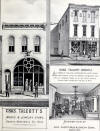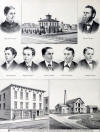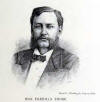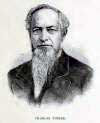|
1878
History
of
Ashtabula Co., Ohio
with Illustrations and Biographical Sketches
of its'
Pioneers and Most
Prominent Men.
Philadelphia
Williams Brothers
1878
256 pgs.
ALSO NOTE: I will transcribe biographies upon request. Please
state the County and State in the Subject line of the email. ~ SW
BIOGRAPHIES
< CLICK HERE to GO to
1878 BIOGRAPHICA INDEX >
< CLICK HERE to GO to LIST of TABLES
of CONTENTS and BIOGRAPHICAL INDEXES >

Res. of
Charles Talcott
Geneva,
Ashtabula Co., O

Chas. Talcotts
Music & Jewelry Store
Geneva, OH |
Geneva
Twp. -
CHARLES TALCOTT.
We take pleasure in presenting the following sketch of the life and
successes of one of Geneva's stirring, go-ahead business men. Born
Sept. 10, 1841, at Garrettsville, Portage county, Ohio, he was the
youngest son of Nelson and Lovisa
Talcott,
of that point. Was educated in the common school, attending the same
until he was thirteen years of age, at which time he began his
apprenticeship as tinner, in the shop of his oldest brother,—Henry,—at
Jefferson; remaining there until twenty years of age, when he took a
course in the Mercantile college at Cleveland, Ohio. Returned to
Jefferson when he had attained his majority, and on Jan. 1, 1863,
associated himself with his brother, before spoken of, in the tin and
hardware trade; continued in business at this point until November of
that year, when the copartnership was dissolved, and Charley removed
to Geneva, making his entree into that village on the 23d day of
November, perched on top of a load of wooden pumps, and in company with V.
J. C. Hodge commenced
business under the firm-name of Talcott Hodge.
The business was at that time carried on in what was known as the old
Mills store, a small one and a half story building, twenty-five by
thirty-five feet, one of the first store buildings erected in Geneva,
and at that time occupying the site of the present brick store of C.
Talcott &
Co. The stock of goods at that time was quite small, amounting with
shop, tools, and fixtures to about three thousand five hundred dollars.
The building was rented of George Turner.
The following year the building was purchased by Talcott
A Hodge,
and a small addition built to accommodate their business, which
increased very rapidly. Business was continued in this store until
1867, at which time Charles Talcott built
the main part of their present hardware-store, on the site of the old
building (the old store being removed a few rods on East Main street,
and occupied by said firm while the new store was being built). The new
store was a substantial brick building, with a frontage on Centre street
of twenty-five feet, running back to East Main, with a frontage on that
street of thirty-five feet, —making a room for hardware twenty-five by
seventy, and the balance of the building being used for a tin-shop.
During this year the interest of Mr. Hodge was
purchased by Charles Talcott,
and he continued the business alone until 1875. The business had now
increased from an annual sale of about five thousand dollars, the first
year, to a sale amounting in 1867 and 1868 to over forty thousand
dollars annually, and it soon became necessary to have more room, which
was accomplished by purchasing the two lots adjoining the store on East
Main street, and extending the building forty feet on that
street,—making the store-room twenty-five by one hundred and ten (the
largest room in the county), and the tin-shop beyond twenty-five by
thirty, with second story same size as the ground-floor, in use for
wareroom and storage. About this time also the third story was built,
and a room finished expressly for the Independent Order of Odd-Fellows,
and leased to them for a period of ten years, and is occupied by them at
the present time, under an extension of lease of ten years longer. It
is said to be the finest hall in the county. In 1871. Mr. Talcott bought
the right for this county of what is known as the “Pope & Tuttle Milk-Rack,"
for butter-makers, and immediately put men into the field canvassing for
it, which resulted in the following years in completely revolutionizing
the business of butter-making in this county. In 1872 the stock of
jewelry owned by H.
B. Hunt was
purchased by Charles Talcott and
removed to his store, where, in company with C.
M. Wright,
the jewelry business was carried on until the spring of 1876, when the
firm was dissolved, and the business continued by Charles Talcott (the
stock being removed in the summer of 1877 to a new building purchased by
him, and adjoining his hardware-store, on the north). In 1875, Philip Doll purchased
a half-interest in the hardware and building, and the firm was changed
from Charles Talcott to Charles Talcott &
Co., with increased capital. The business, already ranking among the
first in the county, was pushed forward with renewed energy and success,
with constantly-increasing sales.
In the autumn of 1876, Messrs.
F. and W. A. Hubbard, under
the title of Hubbard
Bros.,
purchased one-third interest in the hardware and building, and were
admitted as partners to the firm of C.
Talcott & Co.
In 1877 the firm purchased the right for Lake county, and. together
with Mr. Chapin,
of Lenox, the right for Ashtabula County, for what is known as the
“Stickles Milk-Pans," for buttermaking, and later in the season
purchased the right for Ashtabula, Lake, and Geauga counties, of the
Cooly system of butter-making,—a system far superior to anything
heretofore discovered, and which must, when its merits are known, become
adopted. They are now pushing sales vigorously, having men employed in
all of the above-named counties. The firm have a paid-up capital of
twenty-one thousand dollars actually invested in the business, and are
considered among the leading hardware dealers in northern Ohio. The
business management is under the direction of Charles Talcott,
who is also secretary and treasurer of the Enterprise Manufacturing
company, of Geneva (a joint stock company for the manufacture of garden
and household implements), and proprietor of the Geneva music and
jewelry store.
Mr. Talcott has
the exclusive sale of the Knabe, Haines Bros., Hardman,
and Decker Bros,
pianos. In organs, he is also agent for the Estey, Jewett, Goodman, Burdett, Smith,
American, Palace, and Cleveland Organ company. Sales for the year in
instruments, twelve thousand dollars; jewelry, seven thousand dollars.
On the 13th of May, 1863, Mr.
Talcott was
united in marriage to Weltha
M., daughter
of Gates and
Betsy Hyde,
of Lenox. Two children were born of this marriage,—Lewis
C.,
the date of whose birth was Apr. 15, 1866, and Bernice
L.,
born Nov. 10, 1869. Mrs. Talcott died
Nov. 13, 1875, and on the same day in November, 1876, Mr.
Talcott was
again married, to Libbie
H. Churchward,
of Painesville, Lake county, Ohio.
Mr.
Talcott is
a member of the Congregational church, with which he united in 1866.
Politically he is a Prohibitionist, having always taken a lively
interest in temperance matters.
----- Source:
1798 History of Ashtabula County, Ohio with Illustrations and
Biographical Sketches of its Pioneers and Most Prominent Men by Publ.
Philadelphia - Williams Brothers - 1878 - Page 180 |

Talcott Residence
Mr. & Mrs.
Talcott
& Sons,
And Business Blk.,
Mills |
HENRY
TALCOTT was
born in Nelson, Portage county, Ohio, Dec. 28, 1832. His father, Nelson Talcott,
was an extensive chair-manufacturer, and Henry was
placed in the paint department, at the age of eleven, to learn to do
ornamental chair-painting. Winters he attended the high school in
Garrettsville, Ohio, but at the age of seventeen his health failed him,
and he had to abandon the painter’s trade and learn another.
The following spring he commenced to learn the tinner’s trade in
Burton, Geauga county, Ohio, and serving two years’ time there, at
thirty-five dollars and forty-five dollars per year, he then went to
Ravenna, Portage county, Ohio, and worked one year more under
instruction, at one hundred dollars. Out of these sums he clothed
himself entirely and saved fifty-four dollars to commence business
with. And the 1st of August before he was twenty-one years old, he came
to Jefferson, Ohio, and purchased a small tin-shop and stove-store of James Norris,
—consideration seven hundred and thirty-six dollars,—rolled up his
sleeves, and went to work. He never received any aid or assistance from
any quarter, except a loan of two hundred dollars from his father, for
six months, when he first commenced business. This was on Aug. 1 ,
1852. The business interests of Jefferson were very small at that time,
and for that matter were the same all over the county.
Talcott’s
hardware-store was the first one, exclusively in this branch of trade,
started in the county, but the following spring Geo.
C. Hubbard commenced
one in Ashtabula, and has always kept even pace with him, while at the
present time there are at least a dozen good hardware-stores, situated
in different parts of the county, every one of them selling more
hardware than was sold in the whole county, prior to 1850, each year.
The first year's sales amounted to only two thousand eight hundred
dollars, but steadily increased until, 1864, it reached forty thousand
dollars and more, and requiring a stock of from fifteen to twenty
thousand dollars. After adding the sale of Buckeye mowing-machines,
wagons, and agricultural implements, he was compelled to build a large
brick block fifty-two by seventy-five feet, three stories high, to
accommodate this greatly increased business, and in addition to this, he
has an extensive wareroom thirty-two by sixty-five feet, two stories
high. This business has all been built up in the past twenty-five
years. In 1863, always having had a passion for a farm life, he
purchased the old Michael Webster farm,
one mile west of the court-house, one hundred and ninety-six acres,
moved on to it, and commenced farming in addition to his hardware
business. Still later he purchased the old Jonathan
Warner farm,
adjoining his other purchase and also the borough line of Jefferson, and
built him a fine brick residence adjacent to it, but inside the borough,
and is now doing an extensive business breeding thoroughbred short-horn
Durham cattle for sale, and has some very choice animals in his herd,
bred from Clarendon,—five twenty, — Duke
of Clark (2d),
and Royal Britain.
----- Source:
1798 History of Ashtabula County, Ohio with Illustrations and
Biographical Sketches of its Pioneers and Most Prominent Men by Publ.
Philadelphia - Williams Brothers - 1878 - Page 155 |

Hon. Freeman Thorp |
HON. FREEMAN THORP,
of Geneva, a representative in the general assembly, and the subject of
this sketch, was born in a log house in Geneva, June 16, 1844. He is a
son of Dennis
Thorp, Esq.,
a highly-respected citizen, and for many years a justice of the peace of
Geneva township, is a grandson of Aaron Thorp,
one of the early settlers of Austinburg, and a great-grandson of Peter Thorp,
a soldier of the French and Indian war, from Massachusetts colony. Freeman is
the youngest of a family of four, and is by education fairly the product
of our common schools, supplemented by a constant habit of study in
after-life. His early life was passed upon the farm and in the workshop
up to the age of sixteen, when at the breaking out of the war for the
suppression of the Rebellion, in 1861, he enlisted as a private soldier
in Company D, Second Ohio Cavalry, serving three years in that
capacity. His commanding officer said of him at the close of his term
of service, in a letter to the governor of Ohio, “He was a faithful,
conscientious soldier, studious in his leisure moments, his moral and
social qualities excellent, his habits perfect.” This, which was true
of him then, is true of him to-day, being a man of exemplary habits.
After the war he engaged in the practice of photography, studying at the
same time the profession of portrait-painting, in which he soon attained
to high rank, without other aid than such as the best printed works upon
the subject and his own genius and experiments afforded, and in 1870 was
elected an honorary member of a Berlin society of art. This attracted
considerable attention in this country, and coming to the notice of
public men at Washington, they invited Mr. Thorp to
come to that city, and he has practiced his profession there during a
portion of each year with eminent success, standing at this time
securely in the front rank of “ American portrait-painters.” In 1874
his picture was the one accepted in a competitive painting of portraits
of General
Simon Cameron for
the war department; he was honored soon after with a commission from the
President for a portrait of himself, and also a portrait of Mrs. Colonel Fred. Grant.
In 1873, Mr. Thorp declined
an appointment as honorary commissioner to the Vienna exposition,
tendered him by the President, to come home and engage in the political
campaign of that year. In political discussion, Mr. Thorp,
though earnest, is fair and courteous to his political opponents. In
the campaign of 1877 he was nominated on the Republican ticket for
member of the general assembly, having for competitors Hon.
Eusebius E. Lee,
Democrat; Professor
Jacob Tuckerman,
Independent Republican; and Charles Talcott,
Prohibitionist. After a spirited campaign, Mr. Thorp received
a majority over all his competitors, and the certificate of election.
Soon after his election he went to Cincinnati, and entered into
competition with other artists in painting portraits of ex-Attorney-General Alphonso Taft,
for the department of justice at Washington. In this undertaking he
achieved eminent success, distancing all his competitors, and adding
greatly to his professional reputation. His work in Cincinnati was
completed just in time for the commencement of the Sixty-third general
assembly, which began its session in the city of Columbus, Jan. 7,
1878. As a member of the legislature, Mr. Thorp has
been an industrious, conscientious, painstaking member, opposing with
manly firmness and marked ability every abuse of legislative power or
encroachment upon the constitutional rights of the people. His
legislative career begins auspiciously, and gives promise of great
usefulness to the State.
Mr. Thorp was
married Aug. 25, 1865, to Miss
Orlena A. Eggleston,
of Geneva, daughter of E.
M. Eggleston, Esq.,
a skilled mechanic, a foreman in the Geneva Tool company, and a man
greatly respected. They have two children, a daughter, Miss
Nellie I. Thorp,
aged ten, and a son, Clark
L. Thorp,
aged eight.
----- Source:
1798 History of Ashtabula County, Ohio with Illustrations and
Biographical Sketches of its Pioneers and Most Prominent Men by Publ.
Philadelphia - Williams Brothers - 1878 - Page 119 |

Charles Tinker |
Geneva
Twp. -
CHARLES TINKER.
This gentleman is one of the foremost men of the county who are
connected with the mechanical industries. The son of a mechanic, his
natural bent took this direction, and the employment of his life has
been such as to give it ample development. The father, during the
boyhood days of the son, owned a farm in Kingsville township (where the
subject of our sketch was
born on the seventh day of September, 1821), but in the winter time he
applied himself to the trade of wagon-making. Here the son received his
first instruction in the line of mechanical labor. He received a common
school education, such as the limited facilities of those days afforded.
He was united in marriage with Mary Webster,
of his native township, on the twenty-fifth day of September, 1842. Now
he began life for himself in dead earnest. In 1843 he built a saw-mill
on the Conneaut creek, and in the following year he erected an
oil-mill,—the first mill of the kind in that part of the county. In
1850 we find him in Mantua, Portage county, Ohio, where, in 1854, he
built a foundry and machine-shops, and for about six years prosecuted
the business of manufacturing plows, threshing, wood-sawing, and
mowing-machines. Ten years later (in 1864) he is at Garrettsville, on
Silver creek, Portage county, where he is again engaged in the
manufacture of mowing-machines and plows.
At the expiration of four years, in 1868, he formed a partnership
with N.
S. Caswell,
of Geneva, Ohio, and with him began the manufacture of forks and other
small farming tools. The business at Garrettsville and that of Geneva
were continued in conjunction with each other for two years, the wood
work being done at the latter, and the steel work at the former place.
Aug. 1, 1870, these gentlemen, finding that their business had so
grown under their care and attention as to demand the investment of more
capital than they had at command, and recognizing the importance of
concentrating the entire business either at Garrettsville or Geneva,
they submitted a proposition to the citizens of both places to sell out
to a stock company at either point, the condition being that the stock
on hand at both places should be purchased, and the works should be
located at that place which would subscribe the larger amount of stock.
Geneva’s citizens having pledged stock to the amount of eighty-two
thousand five hundred dollars,—a larger sum than the citizens of
Garrettsville could raise,—the works were located at the former place,
and a stock company, with Mr. Tinker as
president, organized, Mr. Caswell becoming
superintendent To the prudent management and business ability of Mr. Tinker was
this successful business strongly due, and he is justly entitled to be
called the father of the Geneva Tool Works enterprise. For seven years
the general management of the company’s affairs was in the hands of Mr. Tinker,
who remained president of the company up to Aug. 1, 1877, and will hold
the said office to August, 1878, if alive.
Although sustaining a serious loss in the fall of 1870, caused by
the burning of the old shops on the South ridge, yet, through the
skillful management of Mr. Tinker and
his fellow-officers, the company was able to pay a cash dividend of ten
per cent, in 1873, and the next year, in addition to a cash dividend of
ten percent, a ten per cent, stock dividend was declared, at which time
the company sold stock enough to make their capital one hundred thousand
dollars. Up to this date, in addition to paying a regular annual
dividend of ten per cent., the company have accumulated a surplus of
twenty-two t housand dollars.
The people of Geneva should ever hold Mr.
Tinker in
grateful remembrance as the founder and chief promoter of this important
manufacturing industry, which has done so much for the growth and
prosperity of their beautiful village.
Mr. Tinker has
made several unsuccessful attempts at farming during the course of his
life; once in Kingsville, immediately after his marriage; once at
Mantua, Portage county, in 1850; once at Geneva, in 1860; and lastly, at
Garrettsville, Portage county. The reason why these attempts were
failures was because he is naturally an artisan and not a farmer.
In 1849, when the gold excitement was at its height, he went to
California by the overland route, with ox-teams, requiring four months
for the journey.
His wife, Mary Webster,
born in Monroe township, this county, July 15, 1820, is the daughter of George
Price and Mary Webster.
Charles
and Mary Tinker are
the parents of five children, viz.: George
L.,
born June 19, 1843, married September, 1874, to Miss
Emma Sharp,
of New Philadelphia, where he now resides; Maria
A. Tinker,
born Dec. 19, 1844, married A.
D. Myers,
of Geneva, Ohio, November, 1864, and died Nov. 28, 1869; Henrietta
L. Tinker,
born Sept. 21, 1846, married Frank Gregory,
of Geneva, Ohio, November, 1863, and now resides in Ashtabula, Ohio; Emma
J. Tinker,
born Feb. 9, 1849, and married Otis
B. Clark,
of Streetsborough, Ohio, Sept. 24, 1867, and now resides in Ashtabula,
Ohio; and Charles
Otis Tinker,
born May 9, 1852, is unmarried, and resides in Ashtabula, Ohio. Mr. Tinker is
deservedly esteemed in a wide circle of friends in Ashtabula County.
----- Source:
1798 History of Ashtabula County, Ohio with Illustrations and
Biographical Sketches of its Pioneers and Most Prominent Men by Publ.
Philadelphia - Williams Brothers - 1878 - Page 176 |
NOTES:
|


![]()
![]()